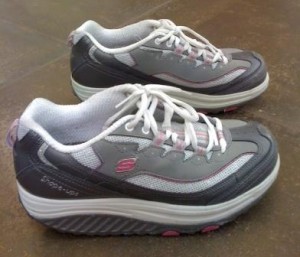
- Shape-up Shoes
Shape-up shoes are a new trend in the fitness world. They are designed to challenge your balance while walking; therefore, increasing muscle tone to your calf, hamstring, core, and gluteus muscles. There are many different brands that make these types of shoes and each brand has a different take on the idea. The Shape- up shoe has a built up sole which brings your center of gravity in a more forward position. Therefore, your hamstrings, gluteus, calf, and core musculature are firing greater to maintain your balance. Compared to wearing normal sneakers, you are working these muscles more with activity.
These shoes are beneficial to people that enjoy walking for exercise and would like to target their hamstring, gluteus, core, and calf muscles. As with ankle/hand weights, shape-ups are another device to challenge your muscles in a different way with weight bearing exercise. For people who work out at the gym or run, this will not substitute your typical exercise routine. This is something you could add to your routine to challenge your balance, while performing your workout.
A lot of these shoes have a rocker bottom sole. Rocker bottom sole shoes have been used for years to help treat patients with certain foot conditions. However, most of the shoes made years ago are not stylish so compliance is always an issue. With Shape-up shoes, they have inadvertently made a shoe with a rocker bottom that is in vogue. Below are some reasons why a person would benefit from a rocker bottom sole shoe.
Depending where the rocker bottom is placed, it has different benefits. If the rocker bottom is placed behind the ball of the foot, it aids in putting less pressure on the ball of the foot and the big toe. Therefore, many people use this type of shoe to help diminish foot pain with walking. When the rocker point is thicker in the back of the shoe, this limits ankle and mid-foot motion. This helps to limit pressure placed on the heel of the foot.
Shape-ups should not be worn by people with balance disorders, chronic back pain, or a history of ankle pain. If you are unsure if you are a candidate for these shoes, consult your doctor or physical therapist.

